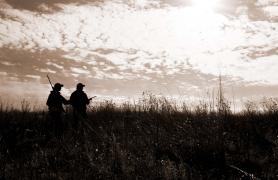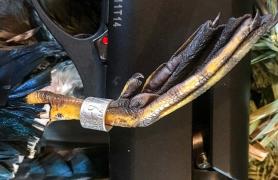A visit to Peck Ranch Conservation Area (CA) is more than a jaunt on a trail or a quick reconnection to nature. It’s a living history lesson in the progress Missouri has made on its promise to protect and manage our state’s wildlife. The elements of this history lesson range from the magnificent and mighty to the small and almost invisible wildlife that call the area home. Just as diverse as the wildlife and habitats are the ways the area can be enjoyed. From overnight primitive camping and extensive trail opportunities to viewing wildlife from the comfort of a vehicle — the intensity of a visit to Peck Ranch is entirely up to the visitor.
Depending on the time of year, a visit to Peck Ranch CA, in northwest Carter County and eastern Shannon County, north of Fremont, can be filled with echoing elk bugles, views of countless white-tailed deer just before sunrise or sunset, strutting wild turkeys, and the bouncy white tail of a striped skunk as it forages through the Timothy grass, red-topped clover, and other vegetation in the fields along Road One. The area has served conservation restoration projects since the 1950s, and just inside the refuge gate are sights of its diverse resident wildlife to prove it.
Preston Mabry, manager of Peck Ranch CA, says the reason for the area’s diversity is intense habitat management. “We have an incredible range of habitat types from old growth forest in the bottomlands to open glades on the hilltops and woodlands of various successional stages all within a relatively close proximity,” Mabry said.
Those habitat types exist and are managed within the nearly 24,000 acres of the area, which is why it’s known as a cornerstone conservation area and tells of so many important conservation victories.
History of the Area
“Before the area was purchased by MDC, the land was farmed, and its timber used to fuel an iron ore company just to the south,” Mabry said. “Because of its remoteness, Peck Ranch still had wildlife on it, despite declines elsewhere. It was initially purchased because it was one of the few areas left with an eastern turkey population.”
In 1952, the final tracts of what would become Peck Ranch CA were acquired for turkey restoration. These tracts included the fenced refuge, roughly 11,000 acres. From 1954 to 1979, turkeys trapped at Peck Ranch and other areas of the state were relocated to 142 sites in 87 counties. The area served whitetailed deer repopulation efforts as well in those early years. In the 1980s and 1990s, collared lizards were re-established at Peck Ranch, and much later, in 2011, the area’s refuge served as the destination for elk relocated to Missouri from the Appalachian Mountains in Kentucky.
Today, Peck Ranch is actively managed using sustainable timber harvest, prescribed fire, mechanical thinning, and open-field green vegetation for elk and white-tailed deer, as well as watershed management. The wildlife diversity viewable from the roadways alone is testament to the habitat management that occurs on the area.
Off the Beaten Path
“Stegall Mountain is an area that I always like to send visitors to,” Mabry said. “Sometimes you have to get off of the beaten path, but the view from some of the glades is well worth it.”
Outside the refuge gate, Stegall Mountain presents a beautiful Ozark glade, where eastern collared lizards sun themselves on the rocks on warm days. Glades are dry, sunny openings in the woodlands where the bedrock is close to the surface, so the soil is very shallow. Plants and wildlife that survive on glades are hardy, like wildlife that survive in the desert. Glades feature native grasses and wildflowers, which support grasshoppers, pollinators, and other insects that in turn support collared lizards and wild turkeys. Populations of the colorful collared lizards have shown an overall decline due to loss of their Ozark glade habitat, making them a Species of Conservation Concern. Now they thrive at Stegall Mountain, thanks to years of glade restoration and habitat management. They live among rocks on dry, open, south- or southwest-facing limestone, sandstone, and granite glades. The best time to see collared lizards is during the warmest part of a day that surpasses temperatures in the low seventies.
“Now you can see collared lizards on almost all the glades on Stegall Mountain, as well as some glades within the refuge,” Mabry said. Also, among the rocks of the glade live
striped scorpions, the most common scorpion in the United States and the only scorpion to live in Missouri.
Although the sting of this scorpion is painful, it is seldom life threatening. Reclusive arachnids, they are rarely seen unless found hiding under a rock. This species provides a rich history lesson, as scorpions first appeared in the fossil record as aquatic animals about 430 million years ago.
The view Mabry referenced is a grand vista, accessed from the large glade rocks or by climbing the fire tower at the top of the mountain. Stegall Mountain is 1,348 feet above sea level, providing an expansive view of the conservation area and beyond — a breathtaking scene of the forested Ozarks.
Practical Tips for Visitors
Several miles of hiking trails, a self-guided driving tour along the rugged area roads, and primitive camping facilities set the stage for a history lesson at Peck Ranch CA. Visitors should expect rough roads and primitive restrooms, along with an unlimited amount of wildlife-viewing opportunities. The best times to see the most wildlife are sunrise and sunset when the elk and deer, particularly, are likely to be out browsing the food plots.
“This area is only accessible via fairly lengthy gravel roads. Some lower profile vehicles may have trouble traversing the terrain,” Mabry said.
Visitors are encouraged to get a map of the area in advance and check the MDC and Ozark Trail websites for area closures. Twin Pines Conservation Education Center in Winona is a good place to stop for information about local history and pick up maps and brochures.
There’s also game hunting outside of the refuge portion of the area under statewide regulations, so visitors should be aware of hunting seasons before going off the beaten path.
Elk Driving Tour
The opportunity to view 75 to 80 elk at a time is still a novelty in Missouri, but it’s very possible at Peck Ranch CA. Due to habitat loss and overhunting by settlers — usually for skins, leaving the meat behind — elk were absent from the state since about 1865. Recent restoration efforts center around their novelty and their importance as a game animal. MDC will begin to consider managed elk hunts when the herd surpasses a population of 200 animals.
For now, Missourians can enjoy elk via the self-guided driving tour, which begins at Peck Ranch CA’s office and is marked throughout the area. It’s open sunrise to sunset seven days a week — except during managed deer hunts, fall firearms deer season, and when roads are closed due to weather. Check short.mdc.mo.gov/ZcT before visiting to ensure the area is open.
David Hasenbeck has been involved with the elk restoration since its inception in 2010 and became the elk program manager in 2013. Hasenbeck advises visitors to Peck Ranch to plan to see more than elk during the driving tour.
When elk restoration began in Missouri in 2011, one of the projected benefits was an increase in tourism to the Missouri Ozarks. It was hoped that the chance to see the majestic buglers would entice travelers to visit the area. That dream is now realized, as shown by MDC Resource Science Division’s recently completed survey that determined the economic impact elk brought to the area.
Visitor surveys conducted at the two self-guided driving elk tours, at Peck Ranch and Current River conservation areas, determined elk brought nearly $1.3 million to
the region in 2016. Throughout the year, MDC conducted on-site visitor surveys at the two elk tour loops. Clerks, stationed at randomly selected locations at various dates and times, interviewed exiting parties and asked them where they were from, their reasons for visiting the area, their associated spending, and whether they saw elk, among other wildlife.
The survey also estimated overall visitation and user attitudes. The data included regional economic impacts, such as food, lodging, and transport expenses. Over 11,000 visitors toured each of the areas in 2016, and only spending by nonlocal visitors was included in the economic impact estimate.
“It’s not uncommon to see deer, turkeys, or even something more uncommon such as a bobcat or a bald eagle on this tour,” he said.
Scenic vistas ranging from Ozark Mountain glades to Ozark streams and spectacular fall foliage are to be expected, he said. Elk, on the other hand, are living animals, which don’t show up on demand. When they do, though, they’re spectacular to see and can range from just a few to up to 75 or 80 animals in one group.
“The easiest time to see the elk is early in the morning or late in the afternoon when they tend to be feeding in the open fields,” Hasenbeck said. “It’s best to look for them shortly after sunrise or an hour or so before sunset.”
Binoculars are handy, and so is the ability to be quiet. Feel free to take photographs and to get out of the vehicle for a better view — but do not disturb the elk or other wildlife in any way. It’s never acceptable to approach an elk and doing so can be dangerous.
“If you have a large group of people or loud children, the noise will make a difference in what you see,” he said. “The elk are somewhat tolerant of vehicles on the driving tour as long as visitors stay back a couple of hundred yards from where they [elk] are.”
Hasenbeck said families and groups of all sizes, including school groups take the self-guided driving tour. Elk bugling occurs in late September and October when rivaling bulls gather their harems together for breeding season. This is when you’re more likely to witness the bulls’ sparring as they establish dominance hierarchies.
“There’s something about seeing wildlife in person and hearing the elk bugles resonate through the area that is an education you can’t get from a book or the internet,” he said. “This is an opportunity to see and learn about something wonderful and wild in our state.”
Take a driving tour
- Peck Ranch Conservation Area The driving loop is marked. The loop begins at the office and runs along roads 1, 11, 13, and 10, with an additional driving route that runs along roads 3, 7, 6, and 5.
- See the Elk at Peck Ranch and Current River Conservation Areas! The 346-square-mile elk restoration zone includes nearby Peck Ranch and Current River conservation areas, which both offer driving tours.
- Current River Conservation Area The driving tour runs from Highway 106 to South Road out of Ellington. The route includes roads 1, 10, and 9, passing the shooting range, the log cabin, and the fire tower.




















Also In This Issue


And More...
This Issue's Staff
Associate Editor - Bonnie Chasteen
Staff Writer - Larry Archer
Staff Writer - Heather Feeler
Staff Writer - Kristie Hilgedick
Staff Writer - Joe Jerek
Creative Director - Stephanie Thurber
Art Director - Cliff White
Designer - Les Fortenberry
Designer - Marci Porter
Photographer - Noppadol Paothong
Photographer - David Stonner
Circulation - Laura Scheuler






















